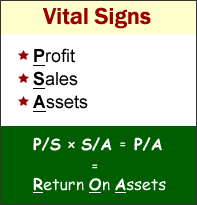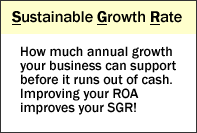How to diagnose for increased profitability
Like a person or your pet, your business needs regular checkups to stay healthy. While you may turn to a medical professional to get advice on your or your pet's health, to whom do you turn for your business?
Professional business consultants are available, but are usually out of the reach of small training practices. The result is that training businesses go without a health checkup. Your business may be limping along, and you don't know why. Your business may look great, but there's something lethal on the horizon that you don't see coming. Or your business may be healthy, but you'd like to get it even more fit.
The good news is that not only are you the Chief Executive Officer, you can also be your own Chief Medical Officer.
The operating health of your training business can be powerfully assessed in 15 minutes by applying a few familiar concepts in new ways. You may not want to try brain surgery quite yet, but you'll be able to assess how well your business is performing, what its intrinsic growth limits are, and what the payoff could be from any improvements you may make.
After you assess your business's health, you should be able to answer the following questions:
- Is my business performing at a level that is healthy for my finances?
- What are the prospects for improving my business?
- Where should I direct my energies to create the most profit?
- If I direct my energies there, what will the payoff be?
First, let's check your vitals: How's your PSA?

Examining a business begins with some simple concepts, not unlike taking your blood pressure, weight, and cholesterol. The concepts we'll use are P(rofit), S(ales), and A(ssets), or PSA. Just as the combined measure of your weight and blood pressure is more meaningful to an MD than weight alone, PSA can be combined to provide a very quick picture of how you're performing—and where you might look to improve your own business.
To gather these figures together, sit down at your desk with a calculator. Determine your profit for the last full year (or last half year). For profit, use net income (the "bottom line" on your financial statement). Then total your sales for the same period. Finally, figure out your average total assets for the same period (average of the current period and the prior period). (Assets are your cash, your receivables, your payables, and your fixed assets like your building. It's the money you have tied up in the business.)
The first way to combine the concepts is to divide Profit by Sales, (P/S). This number will tell you how much of every dollar you take in is available to you as profit. This is an important number for you to have at your fingertips, as it quickly tells you how many cents of every dollar that comes in the door are available to you to reinvest in the business or take out as an extra dividend to yourself.
The second way to combine the concepts is to divide Sales by Assets (S/A), also known as "asset turnover." This measures how well you use your assets to generate sales.
Don't lose sight of this number, sales divided by assets, because it quickly tells you how much bang for the buck you're currently getting. For every dollar of assets you had over the course of the year, how many dollars in sales did you generate? By looking at S/A, you immediately benchmark your sales efficiency. If, say, your ratio produces a 7, that means you generated $7 of sales for every dollar of assets you have in the business. Pretty good for a manufacturing-intensive business, okay for a retailer, and extraordinary for a publisher. But low-overhead service businesses like yours can do far better.
The third way to combine the numbers you know to find the information you don't is to look at Profits divided by Assets (P/A). P/A is a very powerful measure, as it is your Return on Assets (ROA). For every dollar of assets you have, what level of profit did you generate? (The astute observer will note that P/A is simply the product of multiplying (P/S) x (S/A)). Your ROA then is a function of how well you manage your profit margin (P/S) and your asset turnover (S/A). ROA or P/A is the most widely accepted barometer of operating performance, and it will rise or fall depending on how well you can manage profitability and asset efficiency. Dell Computer reports an ROA of approximately 14% and Apple Computer has an ROA of 9.6%. As you might expect, Dell's profit margin is lower than Apple's (6.4% versus 8%), but its asset turnover is double that of Apple.
You graduated! Welcome to the ER
Let's take a look at a patient. I'll call "her" Dog Training Clicks (DTC). DTC generates $250,000 in annual sales, $10,000 in profits, and has average total assets of $100,000. DTC owns the building it operates in, operates 50 weeks a year, and has many classes each day plus day care. It doesn't have any debt, and takes most of its net income year to year and reinvests it back in the business.
According to our healthy business principles, what might we observe about DTC? To begin, we know its profit margin is 4%, and its asset turnover is 2.5—for every dollar of assets DTC is generating $2.50 of sales. Return on Assets is 10%, which means for every dollar that has been invested in this business, the business earned $.10 this year. Put another way, there's a bunch of money invested in this training school and it's earning 10%. Assuming this is all 100% equity-financed (not borrowed money where interest is being paid), that's the same as a return on the owner's equity investment of 10%.
What do you think of the health of DTC? Is it healthy? Is the person running it getting financially healthier? What are the next questions we should ask?
First observation: This business is not generating an adequate return for its owner. Simply investing in the stock market on average generates a 10% pretax return. But the stock market is a highly liquid investment, involving a moderate degree of risk. A training business is not liquid and, like any small business venture, involves a tremendous level of risk. So the owner should expect far more from her investment. Granted, the owner might be paying herself an inflated salary, and therefore artificially driving down the profit, but those are questions to explore. If I were DTC's doctor, I'd say that DTC should generate more of a return for its owner. I'm looking at the equivalent of a 35-year-old woman who has difficulty breathing after walking up a flight of stairs. She should be healthier.
Second observation: There's lots of potential for improvement. How do I know this? I look at the components of ROA and am struck by the profit margins (P/S) of 4% and the asset turnover (S/A) ratio of 2.5. The 4% is small. The owner should be striving for, at a minimum, 10% and ideally 15-20%. The asset turnover of 2.5 is also not all that impressive. A well-run manufacturing company can be turning its assets over far more times than that, and a service company certainly should be. If the profit margin improved to 10% and the asset turnover to 3, the owner would be generating ROA of 30%, which is much more what I would expect from this business. Even if the profit margin stayed at 4% but asset turnover improved to 4, DTC would be generating 16% ROA, which is moving in the right direction. My patient can get better. I've got to lower her blood pressure and reduce her weight.
Third observation: This training company can continue as is and it has the capacity to grow—but not very fast, at only 9% annually. To grow faster, it needs to make fundamental changes that can improve its ROA. In other words, my patient isn't about to die but her quality of life isn't what it should be. She can muddle through with her condition and keep going. If, however, I want to put her on a different quality-of-life trajectory, she MUST engage in some fundamental change: diet, exercise, etc. How do I know this? I combined ROA with two new pieces of information about the company, to calculate the Sustainable Growth Rate (SGR).
Give it to me straight, but be kind!

SGR measures how fast a business can grow assuming that its current operating performance and financial structure remain in place. If it grows faster than its SGR, it will run out of cash. Simplified, the SGR is the product of ROA x Structural Multiplier. What's the "Structural Multiplier?" The structural multiplier is a constant we use to represent how the business is financed, which is a function of how much debt it has relative to its equity and how much of its profit it reinvests back in the business.
To calculate the structural multiplier we need to remember how much equity versus debt the company has, and how much of net income is reinvested back in the company. Remember that this company is 100% equity-financed (has no debt) and that most (90%) of the net income is retained for investment back in the company, not paid out to the owner. In this case, the structural multiplier is .9 and its SGR = (.9 x ROA) = 9%. (For the algebraic minded, more on SGR and the formulas discussed here can be found here.)
So, if this business wants to grow faster than 9%, it has three broad options:
- Add debt or equity to finance the growth. Neither of these is attractive, as the company isn't generating very high profit margins or ROA as it is.
- Plow more earnings back into the company. At best this will have only a marginal effect, because 90% of the earnings go back into the company anyway. But, as noted previously, even if that weren't so, the owner is better off putting that money into the stock market, at least until the ROA improves.
- Improve operating performance. Grow without adding assets at the same rate or grow sales at better profit margins, or both. With an improved ROA to 40%, the company's SGR rises to 36%!
So, now we know we've got to get the company's ROA up. Is improving the ROA possible? Absolutely, but there's a lot of planning and work ahead. It's not crystal clear what actions to take, but I'd begin to formulate my plan by getting answers to three things:
- Why are we only generating 4% profit? What is going on? Is this just a case of my costs being too high relative to my sales? Or am I underpriced in the market?
- Am I using too much working capital in my business? Are we collecting the bills on time? Managing payables?
- How can we generate additional sales without adding assets at the same rate? This is likely to be a big area to explore. We know the owner can't grow the company fast if she needs to invest the same amount in assets as she has in the past. Something needs to change about what and/or how she is selling, we just don't know what—so we'll have to spend more time understanding this area.
Thanks, Doc, I feel better already!
Congratulations! You've already got a grip on this patient's health.
Here's the summary:
The business is not generating an adequate return. To generate a better return it needs to:
- focus on its operating performance
- improve profit margin and/or asset turnover
- look at ways to boost the profit margin on new sales, and/or grow sales in ways that don't involve much growth in the asset base. Small improvements can make a big difference in the company's ROA.
If it doesn't improve these benchmarks, this small business can't grow—or if it grows too fast, it will run out of cash and likely go bankrupt.
Developing and choosing the specific options will take a deeper exploration and understanding of this business. We'll need to runs some tests and spend a bit more time on medical history. We'll be back to the patient soon. In fact, I will be addressing "her" at the upcoming ClickerExpo seminars.
But that's not bad for spending 15 minutes in the doctor's office. Come to think of it, that's pretty much all you get nowadays anyway. And on your way out, don't forget the co-pay.
Previous Articles
- Let's Give Obedience Some Competition Why isn't clicker training on Oprah?








Post new comment